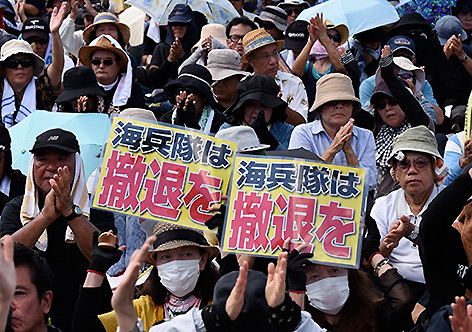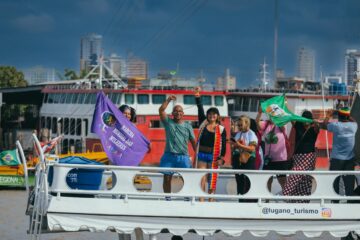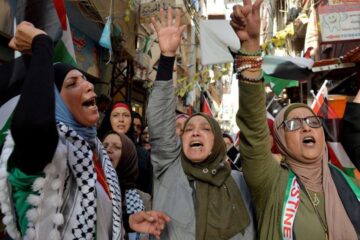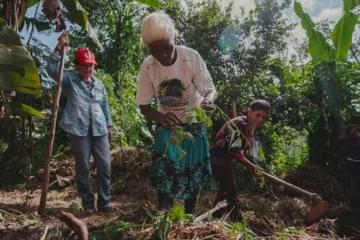First of all, as a Japanese citizen, I would like to apologize for the harm my parents’ generation inflicted on the people of mainland China and the Korean Peninsula during the Pacific War. I would also like to thank you for inviting me to this forum on the Global South and global modernization.
I come from Miyakojima, a small island with a population of 55,000, located 2,000 kilometers from Tokyo and 300 kilometers south of Naha, on the island of Okinawa. From this small island, we can clearly see the future of Japan. The militarization of Miyakojima symbolizes the militarization of Japan.
Battle of Okinawa
In 1944 and 1945, during the Pacific War and the Battle of Okinawa, 30,000 former Japanese soldiers were stationed at Miyakojima, which had a population of 50,000. This happened because the Imperial Headquarters of the Japanese Army was waging a battle on the ground. Miyakojima was reduced to ashes by US and British airstrikes and naval bombers. Many civilians died in these attacks and even more people starved to death as food and medicine ran out. People were reduced to skin and bones; every day, villagers and soldiers died one after the other. A former Japanese soldier wrote a tanka [Japanese short poem] that read, “An island that devours all dogs, cats, and birds and is kept alive by tropical fish.”
During the Pacific War, Okinawa Island became a battleground like a breakwater for mainland Japan. 200,000 people died and the island was reduced to scorched earth. In the following war, so did the islands south of Okinawa, such as Miyako, Yaeyama, and Yonaguni. A military offensive is being prepared to turn this area into a battlefield. Ishigaki and Yonaguni Islands, south of Miyakojima, are called Yaeyama. Since 1637, for 3 generations, the inhabitants of these islands were discriminated against, oppressed, and dispossessed due to the harsh tax system called Nintōzei imposed by the Ryukyu dynasty.
Intensifying Military Expansion
After the defeat in the war, US forces were stationed at Miyakojima. In 1972, when Okinawa was returned to mainland Japan, the hill where the former Japanese military headquarters was located was turned into a communications base for the Self-Defense Forces. These are fortified facilities that are now used as one of the main radar bases for Japan’s air self-defense.
Until the opening of a new Ground Self-Defense Forces base in 2019 and the deployment of a missile unit the following year, Miyakojima had a communications base but no military equipment. About 2,000 members of the Self-Defense Forces are currently stationed with their families there.
In 2012, it was announced that additional electronic warfare units would be deployed and ammunition storage facilities have also been expanded. There is an expansion being undertaken of Ryukyu Islands, from Kyushu to Yonaguni Island, bordering Taiwan, to turn them into military missile strongholds.
Preparations for war take shape
Joint exercises between Japan and the United States have become the norm in the region. More than 100 military exercises were carried out in 2022. The Self-Defense Forces say they are modifying tanks to make them suitable for the southern regions and they are conducting experiments to collect data and simulate what would happen if coral reef islands were bombed. Miyakojima community centers were given “body bags” for local residents.
Moreover, the Ministry of Defense says it will collect blood from 250,000 members of the Self-Defense Forces and manufacture its own “blood transfusion supplies” to freeze and share with the US military on the battlefield. Additionally, the plan for the transportation of the injured includes picking them up at Naha Hospital and then moving them to hospitals across the country. This clearly assumes that the next battlefield will be south of Okinawa Island.
The Self-Defense Forces are expanding their control of intangibles, penetrating the lives, cultural traditions, and even the intimate lives of the local population.
Visit to Yasukuni Shrine
On January 9th, 2024, a group of dozens of people, including the Deputy Chief of Staff of the Ground Self-Defense Forces, visited Yasukuni Shrine, dedicated to war criminals. The next day, it was reported that about 20 people, including the guard commander of the Miyakojima Garrison, drove in official vehicles to visit Miyako Shrine. This violates the Japanese Constitution, which enshrines the principle of separation of church and state, and also violates a Ministry of Defense regulation. It is therefore an act that violates Japan’s national civil control policy.
“Black Hawk Brave” Memorial
In April 2023, the GSDF UH60JA (commonly known as Black Hawk) utility helicopter crashed off the coast of Miyakojima, killing all ten people on board, including the 8th Division executives and the Miyakojima garrison commander. For six days, a memorial (cenotaph) with the inscription “Black Hawk Brave” was built in Utaki, a place of prayer for Okinawan residents who were trapped at the base of Miyako Island.
Describing the victims of the accident as “brave” is tantamount to glorifying war, calling war victims “heroic spirits.” Also, placing such a memorial near the “Utaki,” which is used to prevent death, is an act that demonstrates no understanding of Okinawa’s spiritual culture.
Allusions to the “Great East Asian War” and the “repose of heroic spirits”
In April 2024, a report circulated about an officer of the 32nd Ordinary Regiment of the Ground Self-Defense Forces of the city of Saitama who referred to a “Great East Asian War” and the “repose of heroic spirits.” After the war, the government has not use that term in official documents to refer to the Pacific War. The old Japanese army forced the people to fight as the “Emperor’s Army” and treated the victims as “heroic spirits” as tools to glorify the war. The intention now is to revive that pre-war atmosphere as a “ghost.”
The rising sun flag and the chrysanthemum seal for coming of age celebrations
In January, coming of age celebrations were held in different areas across the city of Miyakojima, and photos of groups from each area were published on the cover of local newspapers. To my surprise, in the group photos from the area where the base was located, behind the youth who were coming of age, there was a “Rising Sun Flag” from the old Navy and even the imperial chrysanthemum seal. This is also a “pre-war ghost.”
Self-Defense Forces “invade” traditional Okinawan culture
In June 2024, different parts of Okinawa held traditional events to call for safe travel and good fishing yield, with the Harley boat race being the main event. On Ishigaki Island, the participation of members of the Self-Defense Forces in Harley was advertised as “official duty” and part of “rowing training” and “sea training.” Upon hearing this, we issued a statement of protest. The final part of our statement reads: “Even on Miyako Island, as the roles of the base are being strengthened and military armaments are expanding, there is a tendency for the Self-Defense Forces to be assimilated by and integrated into older Japanese military, in an atmosphere reminiscent of the pre-war general mobilization system. We oppose their incorporation into the lives of the population.”
At the same time, the website of the 15th Brigade in the city of Naha posted a farewell poem by Lieutenant General Ushijima, former commander of the 32nd Division of the Japanese Army, who decided to “retreat south” during the Battle of Okinawa, which resulted in the death of many Okinawans. Not only that, but the website featured the quote “the green herb of the island, which withers in the autumn, will be revived in the spring of the empire,” which reflects the imperial vision of history and hope in the restoration of the imperial system. Thanks to many voices of protest from Okinawa residents, this content was recently removed from their website.
Reject military colonization of islands
In Japan, huge amounts of national funds are channeled to military expenditures. Most people’s lives are getting worse, with more and more impoverishment. Along with acts to stop the expansion of weapons and war arsenals, we must take steps to prevent the atmosphere on the eve of an upcoming war from invading our lives like a ghost. We are engaged in a nonviolent disobedience struggle.
We, the islanders, will not allow our islands to become a “Gaza over the sea,” a land surrounded by a wall called the ocean.
We refuse to be sacrificed by great powers or to be turned into military colonies of Japan and the United States.
In Conclusion
The issue of the Global South is also an issue of inequality and poverty between North and South. North and South of the world, North and South of Japan. Okinawa corresponds to the south of the two, and the remote Miyakojima, which is literally the south of Okinawa, has become the “island damaged” by the war. We also refuse to become an island of perpetrators. We must build on the strength of international solidarity for peace and continue the struggle, standing in solidarity, to end the war!




